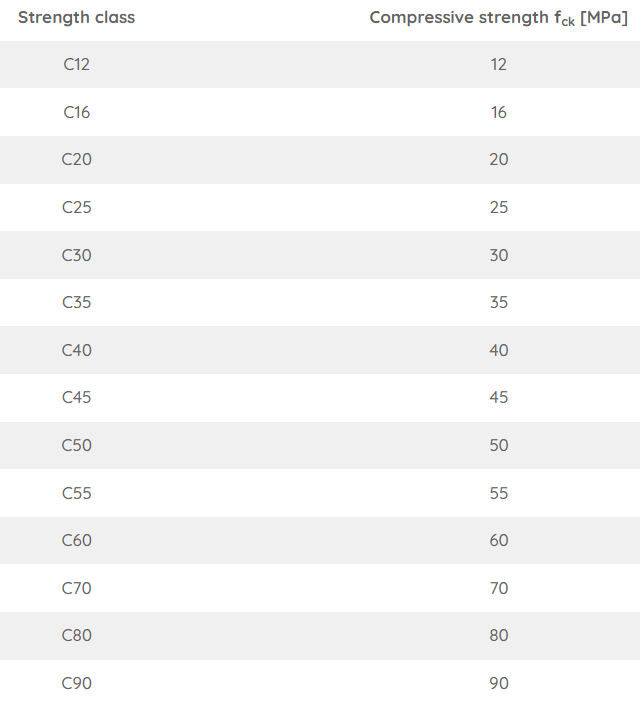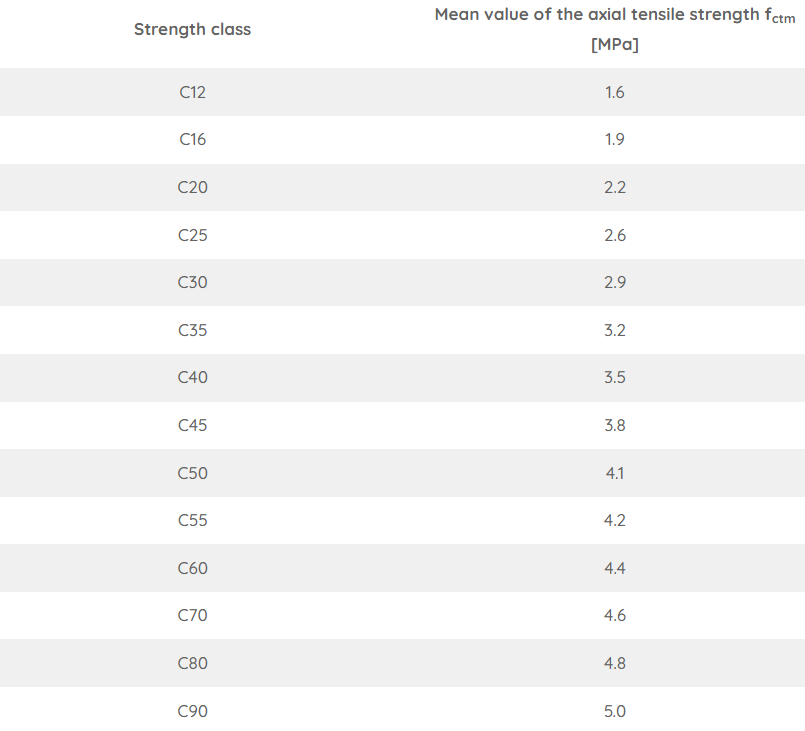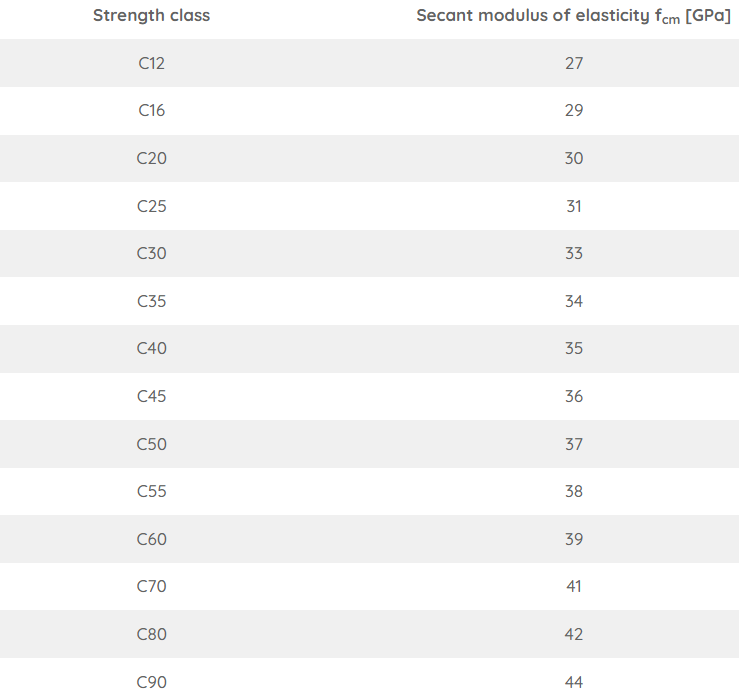Concrete And Reinforcement Properties - An Introduction
Episode #2 of the Reinforced Concrete Series
Hello and happy Wednesday, 👋👋
Today, we’ll quickly introduce the main concrete and reinforcement properties we use to design reinforced concrete beams like the compression strength of concrete, partial safety factors and tensile strength of reinforcement.
These material properties are the fundamentals of structural design.
In this article, we’ll explain what properties are important, where we find them and how to calculate them (if needed).
So, let’s get into it.
The 5 Most Important Concrete Properties
Material properties of concrete and reinforcement are really important for structural design because they define the resistance of the material like compression or tension resistance.
The resistance or strength properties of concrete are defined in EN 1992-1-1 Table 3.1. We’ll summarize it for you below.
In general, concrete has different strength classes, which are categorized by their compression strength. For example, a concrete with the compressive strength of 30 MPa is named a C30 concrete.
Let’s look at the 5 most used concrete properties.
#1 Partial safety factor γc
The value of the partial safety factor can be found in EN 1992-1-1 Table 2.1N. For ULS load combinations, this value is defined as:
And for accidental loads as:
Note that these values are usually defined differently in the National Annex. Make sure to check it.
The partial safety factor is used to calculate the design resistance from the characteristic resistance/strength values, which we’ll define in the next sections.
In general (for all materials) we calculate the design resistance with EN 1990 (6.6c):
With Rk as the characteristic resistance and γM the partial safety factor. In our case, that would be γc.
#2 Compressive strength fck
fck is the characteristic compressive cylinder strength of concrete at 28 days. The values are determined with tests and statistical methods.
The values of fck are defined in EN 1992-1-1 Table 3.1. As said earlier, the strength class is named after the characteristic compressive strength. A C25 concrete has a compressive strength of 25 MPa.
Here’s an overview of the values of fck of the different strength classes.
The compressive strength is used in almost every structural design verification of reinforced concrete. Here are a few examples:
Compression verification
Bending verification
Shear verification
#3 Tensile strength fctm
fctm is the mean value of the axial tensile strength of concrete.
We’ll find the values of fctm in EN 1992-1-1 Table 3.1. Here’s an overview of the different strength classes.
The tensile strength is also used in many structural design verifications. Here are a few examples:
Minimum reinforcement requirement
Bending verification
Shear verification at the interface between 2 concrete casts at different times
#4 E-modulus Ecm
Ecm is the secant modulus of elasticity of concrete.
The E-modulus Ecm is calculated as:
With,
fcm as the mean value of the concrete cylinder compressive strength. The value for fcm can also be found in EN 1992-1-1 Table 3.1.
Or, we’ll find the values of Ecm in EN 1992-1-1 Table 3.1. Here’s an overview of the different strength classes.
The E-modulus is used in the crack width calculation of rc beams and slabs.
#5 Concrete cover
The concrete cover is the closest distance between the edge of the concrete element and the reinforcement.
The cover is used to protect the reinforcement from external influences, which could damage the reinforcement, like water or fire.
Where,
cmin = minimum cover according to EN 1992-1-1 4.4.1.2
Δcdev = allowance in design for deviation according to 4.4.1.3
Now, we won't dive deep into how to calculate cmin and define Δcdev, because it's an article itself. Most countries have the minimum values defined in textbooks for the different reinforced concrete elements, concrete types and environmental conditions.
These were the 5 most important concrete properties. Of course these were not all, but the main ones we’ll be using in the next weeks.
Now, let’s move on to the reinforcement properties..
The 3 Most Important Reinforcement Properties
The second material that is part of reinforced concrete is reinforcing steel or reinforcement.
Let’s check out the 3 main properties of reinforcement, where they are defined and in what verifications they are used.
#1 Partial safety factor γs
The value of the partial safety factor can be found in EN 1992-1-1 Table 2.1N. For ULS load combinations, this value is defined as:
And for accidental loads as:
#2 Tensile strength fy (=yield strength)
fy.k is the characteristic yield strength of reinforcement.
The 2 most common characteristic yield strengths are either 500 MPa or 550 MPa.
The tensile strength is used in the following structural design verifications:
Minimum reinforcement requirement
Cracking verification
Bending verification
Shear verification
etc.
#3 E-modulus Es
Es is the modulus of elasticity of the reinforcing steel.
The E-modulus Es of reinforcement is defined as:
The tensile strength is used in the following structural design verifications:
Calculation of the neutral axis of a cracked rc section
Column design
Cracking verification
etc.
Final Words
That’s it - Quick article today.
As I said earlier, these 5 concrete and 3 reinforcement properties are not the only ones, but the main ones we use in most design verifications. We don’t want to overcomplicate things in the beginning.
I’ll see you next Wednesday for part 3 of the reinforced concrete series. ✌️✌️
Cheers,
Laurin.
What is a beam? [Video tutorial if you need to catch up the basics]
Now, before starting to design reinforced concrete elements, we need to be sure we know the basics of structural engineering such as static systems, loads, cross-section properties.
Beams are the most used element in structural engineering.
Here’s a tutorial on what beams are and how they work, in case you need to catch up.
Enjoy the newsletter? Please forward to a friend you think could like our structural engineering content. It only takes 14 seconds. Making this one took a few hours. Just forward this link: https://www.structuralbasics.com/newsletter/













Hi. Keep this up Laurin. I found your website very useful. BTW, you may want to edit your Ecm as shown in your Secant Modulus of Elasticity table. It says fcm in your table heading instead of Ecm. Thanks!